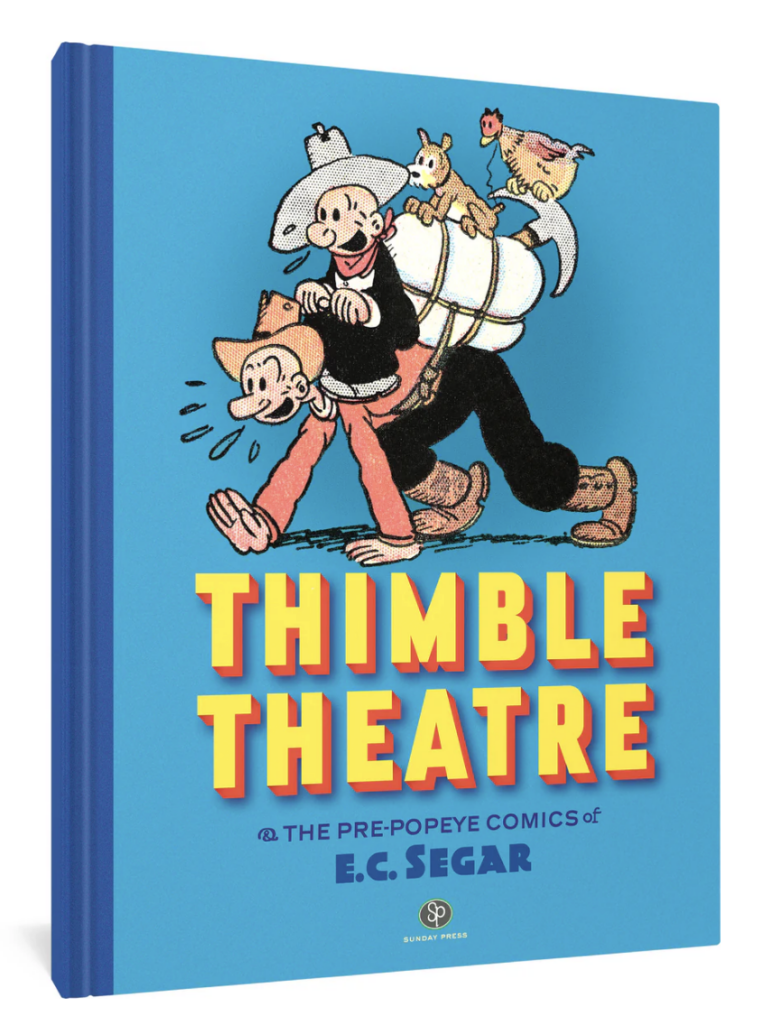Before Popeye Became a Comic Strip Staple, He Enlivened Cartoonist E.C. Segar’s ‘Thimble Theater’
Segar was honing a cockeyed brand of wordplay and a fascination with the grotesque, both of which have earned him comparisons to Dickens and W.C. Fields.

‘Thimble Theater and the Pre-Popeye Comics of E.C. Segar‘
Edited by Peter Maresca
Fantagraphics, 156 pages
Among the observations to be gleaned from a new volume edited by Peter Maresca, “Thimble Theater and the Pre-Popeye Comics of E.C. Segar,” is that Olive Oyl was not always a paragon of gangly femininity.
As seen on February 1, 1925, Ms. Oyl is surprisingly broad-in-the-beam and dowdy in raiment. Her temper, though, is formidable: after wielding an oversized mallet on brother Castor she charges off to give her “sweetie” a similar bop on the head.
Should you think Olive Oyl’s sweetie is a sailor who “fights to the finich/’cause I eats my spinach,” think again.
Popeye wouldn’t appear in the comic pages for another four years, when the cartoonist E.C. Segar introduced him as a bit player in his ongoing strip “Thimble Theater.” When the aforementioned Castor is about to set off on a maritime adventure, he’s in search of a shipman.
Adamant in not hiring “the scum of the earth here in this port,” he spies a figure outside of our purview and bellows “Hey there! Are you a sailor?” The response in the next panel is held dear by comic strip mavens: “Ja think I’m a cowboy?”
Popeye is recognizable in his first appearance on January 17, 1929, but cuts a scruffier figure than he would become once “Thimble Theatre” was rechristened “Popeye” and, especially, upon his becoming a staple of animated cartoons. Could this squinty-eyed reprobate be mistaken for the scum of the earth? Maybe.

For the record, Olive Oyl’s original sweetie — her fiancé, in fact — was a pickle-nosed moocher forever on the make for a rich widower, Ham Gravy. Did Olive trade-up with Popeye? Absolutely, though her designs on the sailor man were, at first, inadvertent.
Eight months after his debut, Popeye is seen minding his own business, whereupon he is approached and then kissed by Olive Oyl. “Oh, excuse me, Popeye — I imagined you were my lover.” Exit the ingénue. Our hero breaks into a sweat. “Blow me down,” Popeye mumbles. And so began a romance for the ages.
We’re getting ahead of the story. The cartoonist Segar had been working a good decade before Popeye wandered onto the set of “Thimble Theater.” Born at Chester, Illinois in 1894, Segar — pronounced, as the artist insisted, “SEE-gar” — knocked about for a time in a variety of jobs before taking a correspondence course in cartooning. His heroes were top-of-the-line artists like George McManus, Rube Goldberg, and, especially, George Herriman.
The landscapes one sees in “The Pre-Popeye Comics” are unimaginable without the example set by Herriman’s “Krazy Kat.” The better part of the book is dedicated to an extended free-form escapade wherein Castor decides to invest in real estate out west: desert property, he tells us, is “dirt cheap.”
Over the course of 80-some Sunday pages — reproduced handsomely here in full color — Castor travels through a landscape that is part southern Utah, part Surrealist dreamscape, and mostly an homage to the environs in which Krazy Kat, Ignatz Mouse, and Officer Pup did their cavorting.
If imitation is the sincerest form of flattery, then Herriman must have been flattered — and he was. In an essay titled “How the West was ‘Tooned,” Herriman’s biographer Michael Tisserand points out how each man would refer to the other in their respective comics.
In the September 14, 1928 edition of “Krazy Kat,” a distant landscape is populated by forms that are clear homages to the pictograph Segar would use as a signature — that is to say, a cigar. Similarly, “Herriman’s rocks” were a feature of the landscapes seen in “Thimble Theater.”
“The Pre-Popeye Comics” features examples of Segar’s first continuing strip, “Charlie Chaplin’s Comic Capers,” and a later feature for the Chicago American, “Looping the Loop.” The former is stiff and disjointed, clearly the work of a novice; the latter is more assured in approach and elastic in its stylizations.
All the while, Segar was honing a cockeyed brand of wordplay and a fascination with the grotesque, both of which have — rightfully, I think — earned him comparisons to Charles Dickens and W.C. Fields.
Who does Castor encounter on his search amongst the craggy reaches of the American west? A displaced Englishman with dirty feet, an esteemed naturalist named Professor Hooey, and his old pal Ham Gravy digging for gold.
When their shenanigans come to an end, Castor and Ham head home — and there we finally see Popeye with Olive Oyl on his lap. Suffice it to say, that’s not how Ham envisioned reuniting with “the finest little girl in the world.”
Fisticuffs ensue with the clear winner being a ferocious and frazzled Olive Oyl. She ends up giving both suitors a sound thrashing. “Love’s a lotta hooey, anyhow!!!” Olive exclaims while striding toward stage left. “The Pre-Popeye Comics of E.C. Segar” is a must for culturati who take pleasure in the rambunctious reaches of American vernacular art.

